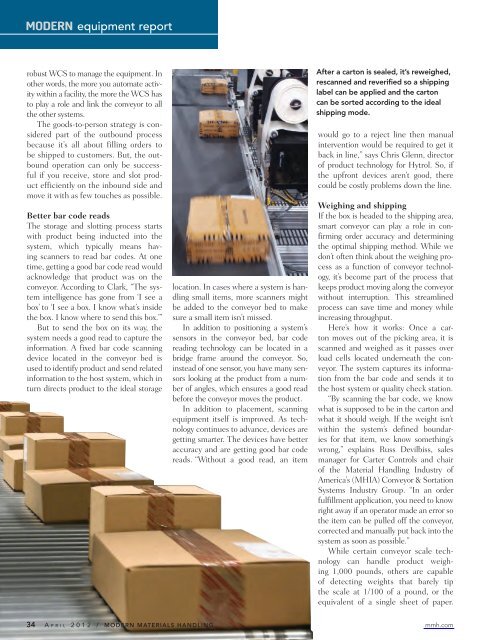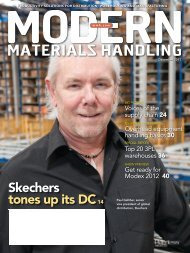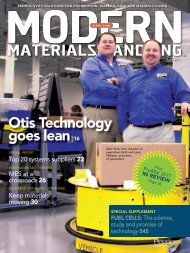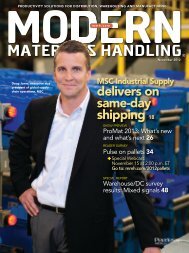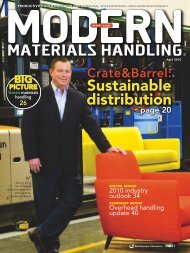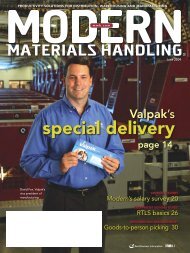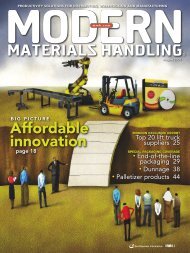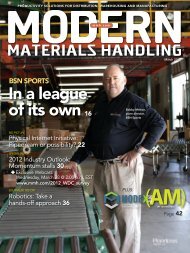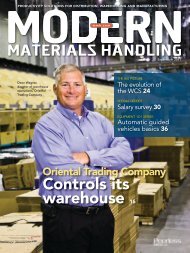Modern Materials Handling - April 2012
Modern Materials Handling - April 2012
Modern Materials Handling - April 2012
You also want an ePaper? Increase the reach of your titles
YUMPU automatically turns print PDFs into web optimized ePapers that Google loves.
modern equipment report<br />
robust WCS to manage the equipment. In<br />
other words, the more you automate activity<br />
within a facility, the more the WCS has<br />
to play a role and link the conveyor to all<br />
the other systems.<br />
The goods-to-person strategy is considered<br />
part of the outbound process<br />
because it’s all about filling orders to<br />
be shipped to customers. But, the outbound<br />
operation can only be successful<br />
if you receive, store and slot product<br />
efficiently on the inbound side and<br />
move it with as few touches as possible.<br />
Better bar code reads<br />
The storage and slotting process starts<br />
with product being inducted into the<br />
system, which typically means having<br />
scanners to read bar codes. At one<br />
time, getting a good bar code read would<br />
acknowledge that product was on the<br />
conveyor. According to Clark, “The system<br />
intelligence has gone from ‘I see a<br />
box’ to ‘I see a box. I know what’s inside<br />
the box. I know where to send this box.’”<br />
But to send the box on its way, the<br />
system needs a good read to capture the<br />
information. A fixed bar code scanning<br />
device located in the conveyor bed is<br />
used to identify product and send related<br />
information to the host system, which in<br />
turn directs product to the ideal storage<br />
location. In cases where a system is handling<br />
small items, more scanners might<br />
be added to the conveyor bed to make<br />
sure a small item isn’t missed.<br />
In addition to positioning a system’s<br />
sensors in the conveyor bed, bar code<br />
reading technology can be located in a<br />
bridge frame around the conveyor. So,<br />
instead of one sensor, you have many sensors<br />
looking at the product from a number<br />
of angles, which ensures a good read<br />
before the conveyor moves the product.<br />
In addition to placement, scanning<br />
equipment itself is improved. As technology<br />
continues to advance, devices are<br />
getting smarter. The devices have better<br />
accuracy and are getting good bar code<br />
reads. “Without a good read, an item<br />
After a carton is sealed, it’s reweighed,<br />
rescanned and reverified so a shipping<br />
label can be applied and the carton<br />
can be sorted according to the ideal<br />
shipping mode.<br />
would go to a reject line then manual<br />
intervention would be required to get it<br />
back in line,” says Chris Glenn, director<br />
of product technology for Hytrol. So, if<br />
the upfront devices aren’t good, there<br />
could be costly problems down the line.<br />
Weighing and shipping<br />
If the box is headed to the shipping area,<br />
smart conveyor can play a role in confirming<br />
order accuracy and determining<br />
the optimal shipping method. While we<br />
don’t often think about the weighing process<br />
as a function of conveyor technology,<br />
it’s become part of the process that<br />
keeps product moving along the conveyor<br />
without interruption. This streamlined<br />
process can save time and money while<br />
increasing throughput.<br />
Here’s how it works: Once a carton<br />
moves out of the picking area, it is<br />
scanned and weighed as it passes over<br />
load cells located underneath the conveyor.<br />
The system captures its information<br />
from the bar code and sends it to<br />
the host system or quality check station.<br />
“By scanning the bar code, we know<br />
what is supposed to be in the carton and<br />
what it should weigh. If the weight isn’t<br />
within the system’s defined boundaries<br />
for that item, we know something’s<br />
wrong,” explains Russ Devilbiss, sales<br />
manager for Carter Controls and chair<br />
of the Material <strong>Handling</strong> Industry of<br />
America’s (MHIA) Conveyor & Sortation<br />
Systems Industry Group. “In an order<br />
fulfillment application, you need to know<br />
right away if an operator made an error so<br />
the item can be pulled off the conveyor,<br />
corrected and manually put back into the<br />
system as soon as possible.”<br />
While certain conveyor scale technology<br />
can handle product weighing<br />
1,000 pounds, others are capable<br />
of detecting weights that barely tip<br />
the scale at 1/100 of a pound, or the<br />
equivalent of a single sheet of paper.<br />
34 A p r i l 2 0 1 2 / <strong>Modern</strong> <strong>Materials</strong> <strong>Handling</strong> mmh.com


